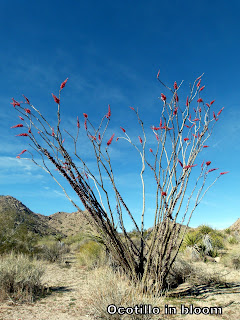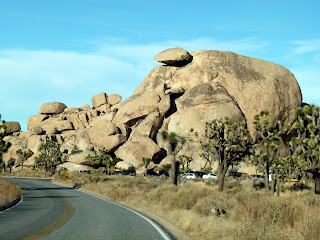
Most Ocotillo trees have no leaves and rarely bloom. They are 15 feet tall and have nasty spikes on the branches, but are not cacti. After heavy rains the leafless stems carry out photosynthesis
 then form fleshy leaves and sometimes bloom. When dry conditions persist they drop all their leaves turn brown and wait for the next rain.
then form fleshy leaves and sometimes bloom. When dry conditions persist they drop all their leaves turn brown and wait for the next rain. We were very fortunate to see this one blooming. Apparently, this was the only bush blooming in the Park. Beautiful flowers, but too high to smell. The nasty spikes would get you first!

No idea what these bushy seed pods are, but they were pretty.

These beautiful, but very nasty cacti are called silver or teddybear cholla (choya). It is not recommended that you touch this as the 1 inch spiney joints will readily attach to you.
Joshua trees are very strangely shaped and are not really trees, but in the yucca family. We did see the
remains of some blossoms, but most were dead.

 This tree was beside the road and more branched than most.
This tree was beside the road and more branched than most.
We enjoyed a picnic lunch at this rocky outcropping. The rock formations were fascinating and we hiked part of the Split Rock trail. We think there's a baboon in this photo, can you spot him?

The rock Gord is standing beside is Split Rock, you can see part of the split at the very top, it's the dark streak and it goes all the way around it. The trail is well marked and goes off to the left through more amazing rock formations.

This is another split rock, in reality much bigger than it looks here.

The view from Keys Lookout at Joshua Tree National Park is amazing. Extremely windy up here, but beautiful. The view goes to Salton Sea and on a clear day you can see the Baja Peninsula.

Piles of rocks were everywhere and we often wondered why they didn't fall. People were climbing all over them. The huge one on top looked as if it could come down on those little cars any time.

No idea why that round rock didn't roll down or why there was an odd brick-like formation running through the gigantic flat rocks.

Although we have a great Audubon guide for this area, we cannot identify this plant or the one below.
Zoom in on this one if you can, as it is quite stunning.


No comments:
Post a Comment